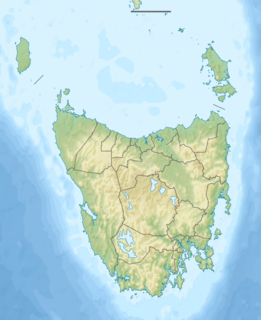This article needs additional citations for verification .(August 2014) (Learn how and when to remove this template message) |

Tasmanian Conservation Trust is a Tasmania's oldest non-profit conservation organisation; it was formed in 1968. [1] The Trust has a comprehensive and interactive website Tasmanian Conservation Trust and operates a Facebook page.

Tasmania is an island state of Australia. It is located 240 km (150 mi) to the south of the Australian mainland, separated by Bass Strait. The state encompasses the main island of Tasmania, the 26th-largest island in the world, and the surrounding 334 islands. The state has a population of around 526,700 as of March 2018. Just over forty percent of the population resides in the Greater Hobart precinct, which forms the metropolitan area of the state capital and largest city, Hobart.
A nonprofit organization, also known as a non-business entity, not-for-profit organization, or nonprofit institution, is dedicated to furthering a particular social cause or advocating for a shared point of view. In economic terms, it is an organization that uses its surplus of the revenues to further achieve its ultimate objective, rather than distributing its income to the organization's shareholders, leaders, or members. Nonprofits are tax exempt or charitable, meaning they do not pay income tax on the money that they receive for their organization. They can operate in religious, scientific, research, or educational settings.

Conservation is an is a common job of every humans to be done in the earth.It is the protection of the FLORA and FAUNA with their habitat like seas, forests and flourished trees. Its primary focus is upon maintaining the health of the natural world, its fisheries, habitats, and biological diversity. Secondary focus is on material conservation, including non-renewable resources such as metals, minerals and fossil fuels, and energy conservation, which is important to protect the natural world. Those who follow the conservation ethic and, especially, those who advocate or work toward conservation goals are termed conservationists.
Contents
The Trust is an independent advocate and guardian for conservation and biodiversity in Tasmania.

Biodiversity refers to the variety and variability of life on Earth. Biodiversity is typically a measure of variation at the genetic, species, and ecosystem level. Terrestrial biodiversity is usually greater near the equator, which is the result of the warm climate and high primary productivity. Biodiversity is not distributed evenly on Earth, and is richest in the tropics. These tropical forest ecosystems cover less than 10 percent of earth's surface, and contain about 90 percent of the world's species. Marine biodiversity is usually highest along coasts in the Western Pacific, where sea surface temperature is highest, and in the mid-latitudinal band in all oceans. There are latitudinal gradients in species diversity. Biodiversity generally tends to cluster in hotspots, and has been increasing through time, but will be likely to slow in the future.
The Trust publishes a quarterly journal Tasmanian Conservationist on current conservation issues, campaigns and news updates.













